Butterflies of the Adirondacks:
Viceroy (Limenitis archippus)
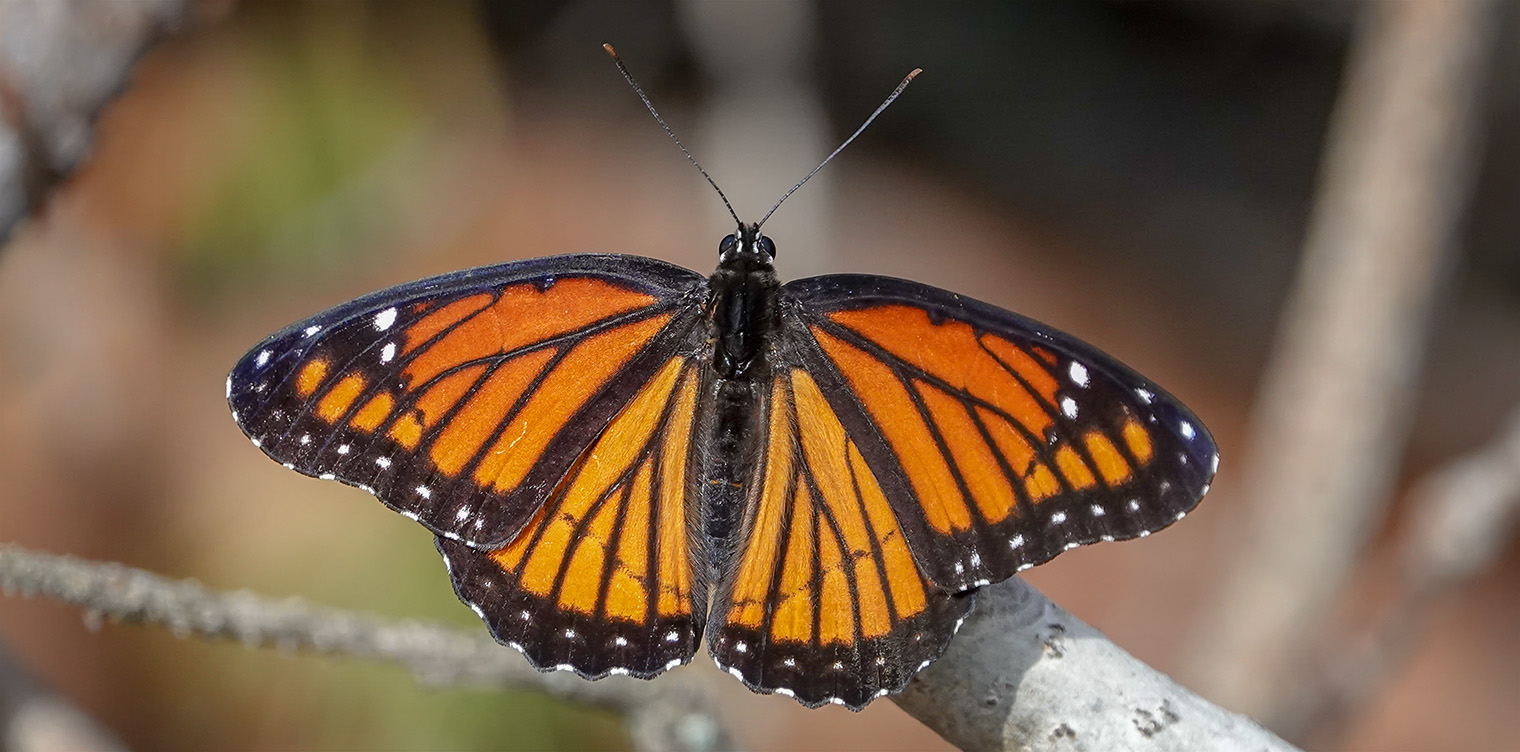
The Viceroy (Limenitis archippus) is an orange and black butterfly found in a variety of open habitats. Seen from a distance, it resembles the larger, but unrelated, Monarch. There are seven subspecies of Viceroy. [1] Our subspecies is Limenitis archippus archippus. [2]
Viceroy: Identification
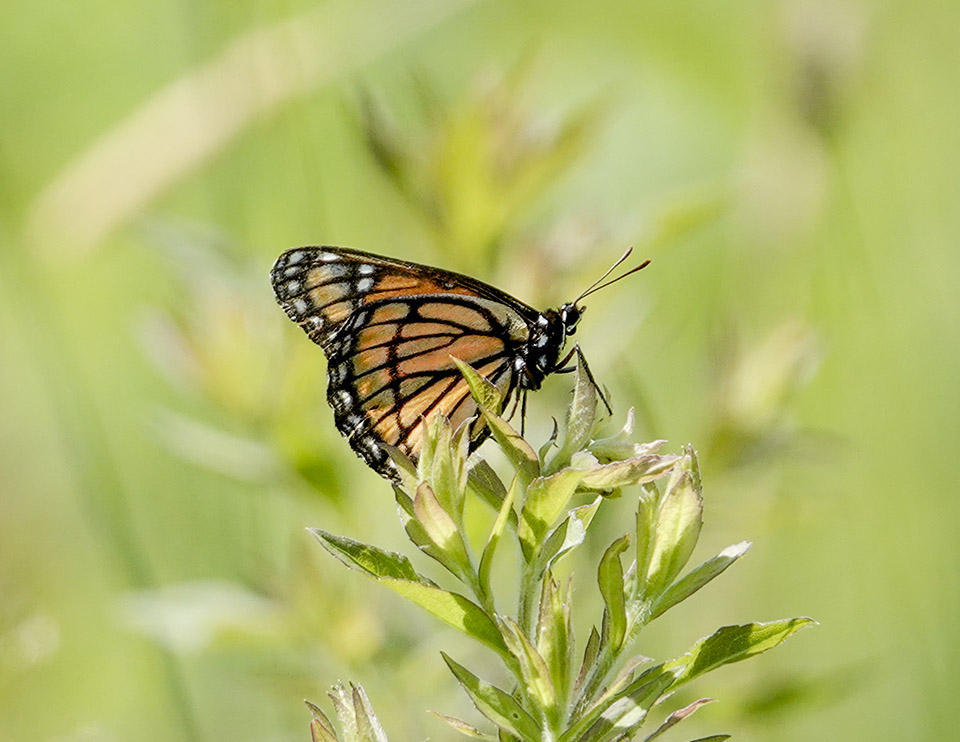
The adult Viceroy is a medium-sized orange butterfly with black markings. From above (the dorsal surfaceDorsal surface: The top side of a wing. ), the wings are dark orange with prominent black veins. The Viceroy has wide black wing borders with a row of white spots and a black line on both wings. The underside ( the ventral surfaceVentral surface: The underside of a wing. ) is similar, but somewhat paler. [3]
The Viceroy can be distinguished from the Monarch by the presence of the black line (which the Monarch does not have), as well as by the fact that it is noticeably smaller than the Monarch. The Viceroy's wingspan is 2⅝ to three inches, while that of the Monarch is 3½ to four inches. [4] The flight patterns are also different. While the Monarch sails with its wing held in a "V", the Viceroy glides on flat wings. [5]
Viceroys in most parts of their range mimic Monarchs, sporting wings that are a rich orange (about the same shade as that of a Monarch). [6] However, Viceroys in parts of the country where Monarchs are rare (Florida, Georgia, and the Southwest) are a darker chestnut brown, resembling the Queen (a relative of the Monarch). [7] [8]
At one time, scientists thought that Viceroys were palatable to birds and that their mimicry of Monarchs was a survival strategy to convince birds not to prey on them. This survival strategy is called Batesian mimicry – a form of mimicry in which one harmless species that is palatable to a predator mimics the appearance of a harmful or noxious species. [9]
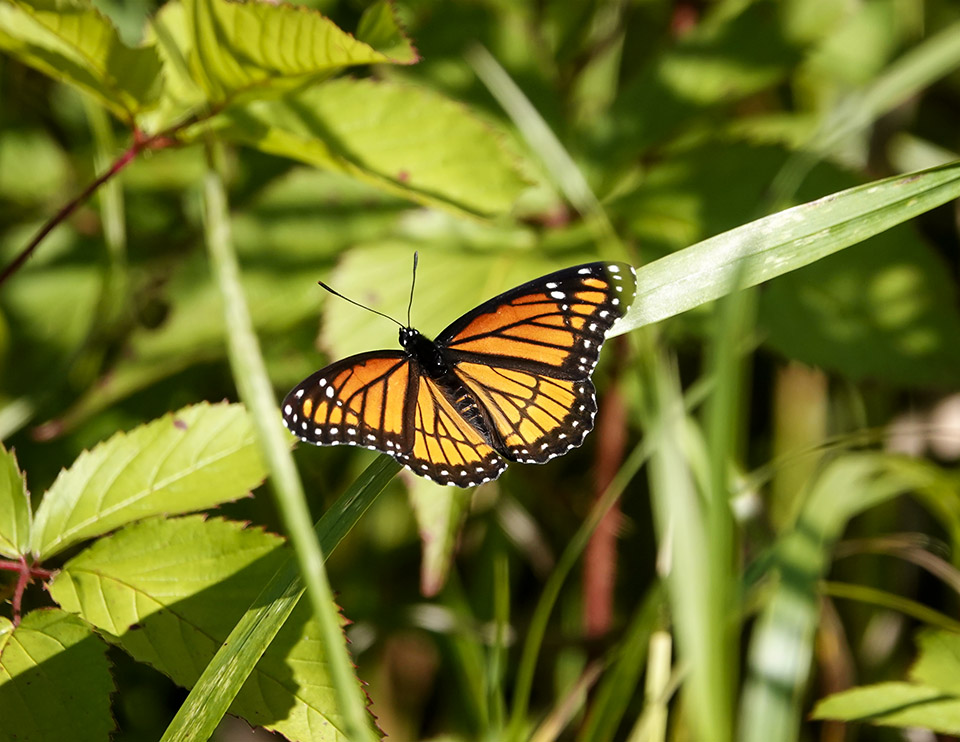
Later research, including experiments tracking predation on Viceroys by Red-winged Blackbirds, found that Viceroys are themselves unpalatable to birds. [10] Hence, their mimicry is actually an example of Mullerian mimicry, when two equally noxious species evolve to look similar to each other. [11] [12] This strategy is based on the theory that a predator which learns to avoid one of the noxious species will avoid the mimic species as well.
The eggs of Viceroys mimic a gall on its host plantHost Plant: The food plant of a caterpillar. Most species of butterfly will only eat a single plant (or group of related plants) as caterpillars. The particular plant that a caterpillar will eat is called the host plant for that species of butterfly.. [13] The eggs are dome-shaped, with the surface covered with hexagonal cells. The eggs are pale green or pale yellow, becoming gray. [14]
Viceroy caterpillars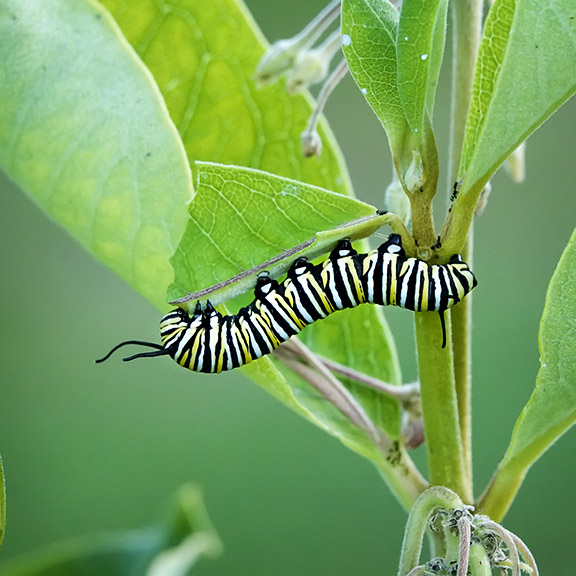 Caterpillar: Butterflies and moths develop through a process called metamorphosis, which entails four states: eggs, caterpillar (larva), pupa, and adult. The caterpillar, representing the second state in the life cycle, hatches from the egg. Its primary activity is eating. The caterpillars first eats its eggshell and then begins consuming the leaves on which the egg was laid. Newly-born caterpillars are very small and expand as they start growing. Because the exoskeleton does not stretch, the caterpillar grows by molting (shedding its skin). The stages between larval molts are called instars. mimic bird droppings. [15] They are variable in color. [16] They are generally mottled brown or olive and hump-backed with a pinkish-white saddle-shaped patch on the back. [17] Caterpillars have a pair of antenna-like structure on the front end of the thorax. [18] [19]
Caterpillar: Butterflies and moths develop through a process called metamorphosis, which entails four states: eggs, caterpillar (larva), pupa, and adult. The caterpillar, representing the second state in the life cycle, hatches from the egg. Its primary activity is eating. The caterpillars first eats its eggshell and then begins consuming the leaves on which the egg was laid. Newly-born caterpillars are very small and expand as they start growing. Because the exoskeleton does not stretch, the caterpillar grows by molting (shedding its skin). The stages between larval molts are called instars. mimic bird droppings. [15] They are variable in color. [16] They are generally mottled brown or olive and hump-backed with a pinkish-white saddle-shaped patch on the back. [17] Caterpillars have a pair of antenna-like structure on the front end of the thorax. [18] [19]
The chrysalisChrysalis: The hard outer shell of a pupa. of a Viceroy also resembles a bird dropping. [20] The chrysalis is dark brown, with a projecting bump on the back and a whitish abdomen. [21]
Viceroy: Life History
Male Viceroys perch on low vegetation, periodically patrolling back and forth in search of females. The same perch is often used in successive generations. [22]
Female Viceroys lay eggs singly on the tip of host leaves, depositing two or three eggs at a time on each plant. [23] The Viceroy's main host plantHost Plant: The food plant of a caterpillar. Most species of butterfly will only eat a single plant (or group of related plants) as caterpillars. The particular plant that a caterpillar will eat is called the host plant for that species of butterfly. are trees in the willow family, especially small, shrubby species. [24] Although female Viceroys will also lay their eggs on poplars and some fruit trees, the willow (Salix) is the preferred host plant. [25] Eggs hatch in about six days, depending on temperature. [26]
After the eggs hatch, caterpillars eat their eggshells, then begin feeding on the catkins and leaves of the host plant. [27] The young larvae reportedly construct a ball of leaf litter, dung, and silk which dangles from the leaf they are feeding on. [28] Third-stage caterpillars overwinter in a shelter constructed from the leaf of the host plant, emerging with the new leaves the following spring. [29]
Sources differ on the feeding habits of adult Viceroys. Opler and Krizak indicate that the food source varies seasonally, with early brood Viceroys relying on carrion, decaying fungi, aphid honeydew and animal dung, later switching to flowers such as Joe Pye Weed, asters, and goldenrods. [30] However, observers in Massachusetts have seen Viceroys early in the season nectaring on plants, such as arrowwood and Grey-stemmed Dogwood, with later-season Viceroys seen on summer-blooming plants such as aster, goldenrods, and milkweeds. [31]
Viceroy: Habitat and Range
Viceroys are found throughout the US east of the Sierra Nevada and Cascade Mountains to central Mexico. [32] It is also widespread in Canada, ranging from Nova Scotia to Quebec and Ontario, north to James Bay, and in the Prairie Provinces to the northern borders. [33]
Viceroy habitat includes moist open or shrubby areas, such as willow thickets, the edges of swamps, wet meadows, streamsides, and roadsides. [34] [35] [36] [37] They are said to be found most frequently along streams where willows are found. [38]
Viceroy: Flight
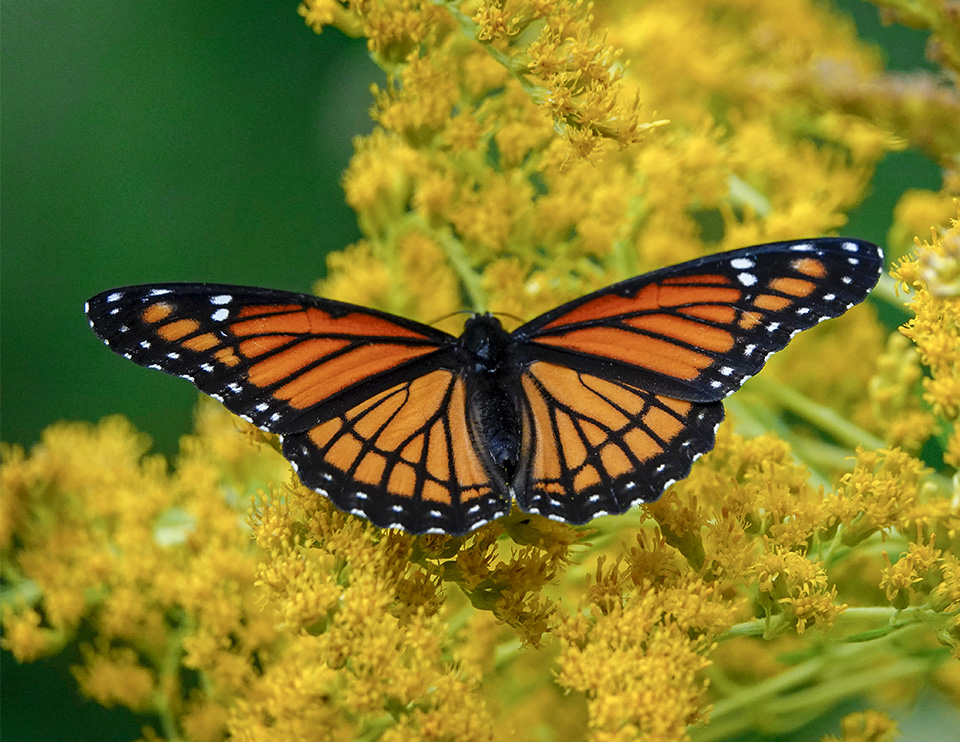
The flight period of Viceroys, as with all butterflies, varies with region and shifts from year to year. The Viceroy is said to have two to three broods flying from May to September throughout most of its range, all year in Florida. [39] [40]
- In Massachusetts, there are reportedly three broods. The flight period is from late May to early October, with peak numbers in mid-June and late July/early August. [41] [42]
- In Wisconsin, there are two broods, with Viceroys flying from late May through July and then again from late July into September. [43]
- In the New York City region of New York State, the Viceroy flies from late May through mid-October, with the greatest abundance from the second week of July to the third week of August. [44]
- In Canada, there are two overlapping generations flying from late May into September. [45]
The flight period and abundance of the Viceroy within the Adirondack Park can only be roughly estimated, based mainly on a very limited number of verified sightings on Butterflies and Moths of North America (BAMONA) and reported observations on iNaturalist.
- The advantage of iNaturalist is that it is a popular citizen science web site that attracts many observers, in part because it covers both plants and animals and in part because the process of submitting an observation is very easy. The disadvantage is that an individual observation can achieve "research-grade" status by being confirmed by the observer and one additional individual, who may or may not have expertise in that particular taxa.
- The advantage of BAMONA is that sightings are verified by regional specialists who are recognized experts. The disadvantage is that there are fewer sighting records for most species, partly because the site covers only butterflies and moths and partly because the process of submitting a sighting is more complicated.
- Both data sets share a common problem of citizen science: reported trends may reflect trends in the number of observers and their willingness to submit reports, not the abundance of the butterfly in question.
With these caveats in mind, it appears that Viceroys are seen in the Adirondack region intermittently throughout the summer, similar to the pattern observed in Canada.
- Viceroys have been intermittent guests at the Paul Smith's College VIC Native Species Butterfly House, which collects its butterfly and moth residents from the immediate area. [46] In 2012, Viceroys were logged as being present on 23 days, intermittently throughout June, then in early July, and in early August. In 2013, Viceroys were listed as present in the Butterfly House for 17 days. They were present in late June, in mid-July, in late August, and very early September. The 2014 logbook was not available. In 2015, Viceroys were listed as present in the Butterfly House for 14 days. They were present in mid-June, mid-July, and the third week of August. In 2016, Viceroys were listed as present in the Butterfly House for 17 days. They were present in late June and intermittently in the last two weeks of August.
- BAMONA lists 102 verified sightings of Viceroys in New York State, only 11 in the Adirondack Park. The Adirondack sightings cluster in late June and again in August.[47]
- There have been 31 research-grade observations of adult Viceroys within the Adirondack Park Blue Line in iNaturalist. [48] (This compares to the 457 research-grade observations within the Adirondack Park for the most popular and abundant butterfly: the Monarch.) The observations for the Viceroy range from late June to early September. [49] [50] [51] [52] [53]
References
- Susan Grimm Hanley. Interpretive Naturalist, Paul Smith's College Native Species Butterfly House. Species Logbooks.
- Butterflies and Moths of North American. Species Profiles. Viceroy. Limenitis archippus. Retrieved 24 October 2019.
- Butterflies and Moths of North American. Sighting Records. Viceroy. Limenitis archippus. Retrieved 27 October 2019.
- iNaturalist. Viceroy. Limenitis archippus. Retrieved 16 August 2021.
- iNaturalist. Adirondack Park Sightings. Viceroy. Limenitis archippus. Retrieved 16 August 2021.
- iNaturalist. Adirondack Park Sightings 2016. Viceroy. Limenitis archippus. Retrieved 16 August 2021.
- iNaturalist. Adirondack Park Sightings 2017. Viceroy. Limenitis archippus. Retrieved 16 August 2021.
- Naturalist. Adirondack Park Sightings 2018. Viceroy. Limenitis archippus. Retrieved 16 August 2021.
- iNaturalist. Adirondack Park Sightings 2019. Viceroy. Limenitis archippus. Retrieved 16 August 2021.
- iNaturalist. Adirondack Park Sightings 2020. Viceroy. Limenitis archippus. Retrieved 16 August 2021.
- Government of Canada. Canadian Biodiversity Information Facility. Species Bank. Viceroy. Limenitis archippus. Retrieved 24 October 2019.
- Massachusetts Butterfly Club. Massachusetts Butterfly Species List. Viceroy. Limenitis archippus. Retrieved 24 October 2019.
- Massachusetts Audubon. Butterfly Atlas Species Accounts. Viceroy. Limenitis archippus. Retrieved 24 October 2019.
- The Butterflies of Massachusetts. Viceroy. Limenitis archippus. Retrieved 24 October 2019.
- McFarland, Kent P. and Bryan Pfeiffer. Vermont Butterfly Survey. Vermont Center for Ecostudies – Vermont Atlas of Life. Viceroy. Limenitis archippus. Retrieved 24 October 2019.
- Integrated Taxonomic Information System On-line Database. Limenitis archippus. Retrieved 24 October 2019.
- IUCN Red List of Threatened Species. Limenitis archippus Cramer. Retrieved 24 October 2019.
- Iowa State University. Department of Entomology. BugGuide. Limenitis archippus. Viceroy. Retrieved 24 October 2019.
- Wisconsin Butterflies. Viceroy. Limenitis archippus. Retrieved 24 October 2019.
- Montana Field Guides. Viceroy. Limenitis archippus. Retrieved 24 October 2019.
- Ross Layberry, Peter Hall, and Don Lafontaine. The Butterflies of Canada (University of Toronto Press, 1998), pp. 209-210.
- Thomas J. Allen, Jim P. Brock, James P. Brock, Jeffrey Glassberg. Caterpillars in the Field and Garden: A Field Guide to the Butterfly Caterpillars of North America (Oxford University Press, 2005), pp. 100-101.
- David L. Wagner. Caterpillars of Eastern North America: A Guide to Identification and Natural History (Princeton University Press, 2010), pp.130.
- National Audubon Society. Field Guide to Butterflies (New York: Alfred A. Knopf, 1981), pp. 637-638, Plates 26 and 597.
- Jeffrey Glassberg. Butterflies of North America (Sterling Publishing Company, 2011), pp. 160-161.
- Jeffrey Glassberg. Butterflies through Binoculars. The East. A Field Guide to the Butterflies of Eastern North America (Oxford University Press, 1999), p. 128, Plates 38 and 45.
- Jeffrey Glassberg. A Swift Guide to Butterflies of North America. Second Edition. (Princeton University Press, 2017), p. 234.
- Jim P. Brock and Kenn Kaufman. Kaufman Field Guide to Butterflies of North America (Houghton Mifflin, 2003), pp. 210-211.
- Paul A. Opler. A Field Guide to Eastern Butterflies (The Peterson Field Guide Series, Houghton Mifflin Company, 1992,1998), pp. 48-49, 90-91, 279-280.
- James A. Scott. The Butterflies of North America. A Natural History and Field Guide (Stanford University Press, 1986), pp. 259-260, Plates 19 and 64.
- Donald and Lillian Stokes. Stokes Butterfly Book. The Complete Guide to Butterfly Gardening, Identification, and Behavior (Little, Brown and Company, 1991), pp. 80-83.
- Paul A. Opler and George O. Krizek. Butterflies East of the Great Plains: An Illustrated Natural History (The Johns Hopkins University Press, 1984), pp. 167-168, Plate 32, Map 147.
- Rick Cech and Guy Tudor. Butterflies of the East Coast. An Observer's Guide (Princeton University Press, 2005), p.198.
- David Carter. Butterflies and Moths (Dorling Kindersley, Inc., 1992), p. 124.
- Harry K. Clench, "Behavioral Thermoregulation in Butterflies," Ecology, Volume 47, Number 6 (November 1966), pp. 1021-1034. Retrieved 24 October 2019.
- David B. Ritland, "Comparative Unpalatability of Mimetic Viceroy Butterflies (Limenitis archippus) from Four South-eastern United States Populations," Oecologia, Volume 103, Number 3 (1995), pp. 327-336. Retrieved 26 October 2019.
- David B. Ritland, "Revising a Classic Butterfly Mimicry Scenario: Demonstration of Müllerian Mimicry between Florida Viceroys (Limenitis archippus floridensis) and Queens (Danaus gilippus berenice)," Evolution, Volume 45, Number 4 (June 1991), pp. 918-934. Retrieved 26 October 2019.
- David B. Ritland, "Mimicry-Related Predation on Two Viceroy Butterfly (Limenitis archippus) Phenotypes," The American Midland Naturalist, Volume 140, Number 1 (July 1998), pp. 1-20. Retrieved 26 October 2019.
- Jane van Zandt Brower, "Experimental Studies of Mimicry in Some North American Butterflies: Part I. The Monarch, Danaus plexippus, and Viceroy, Limenitis archippus archippus," Evolution, Volume 12, Number 1 (March 1958), pp. 32-47. Retrieved 26 October 2019.
